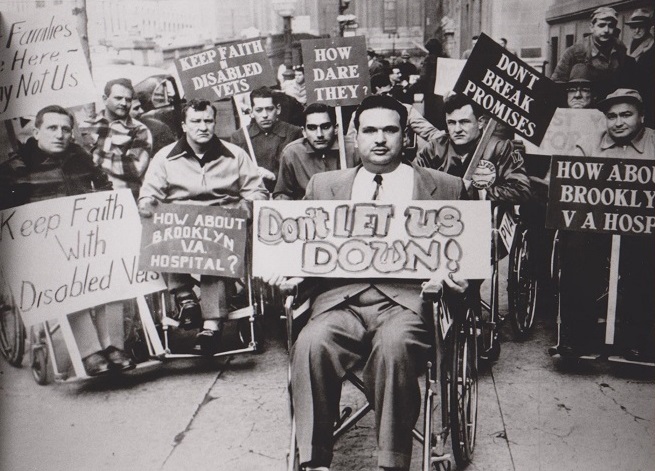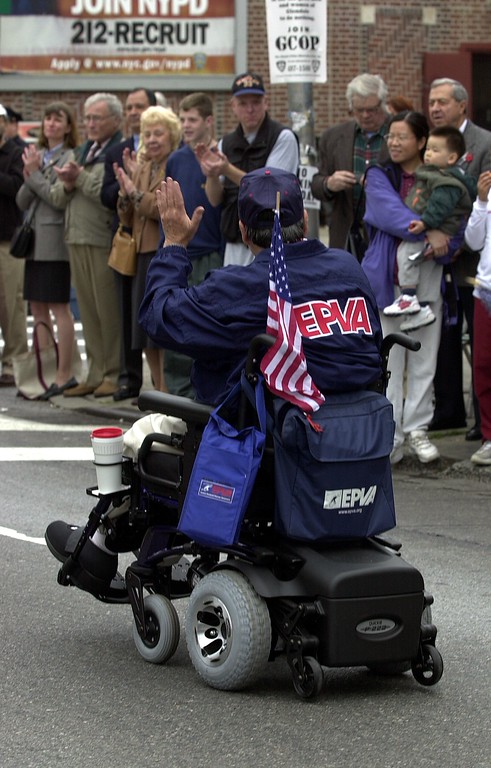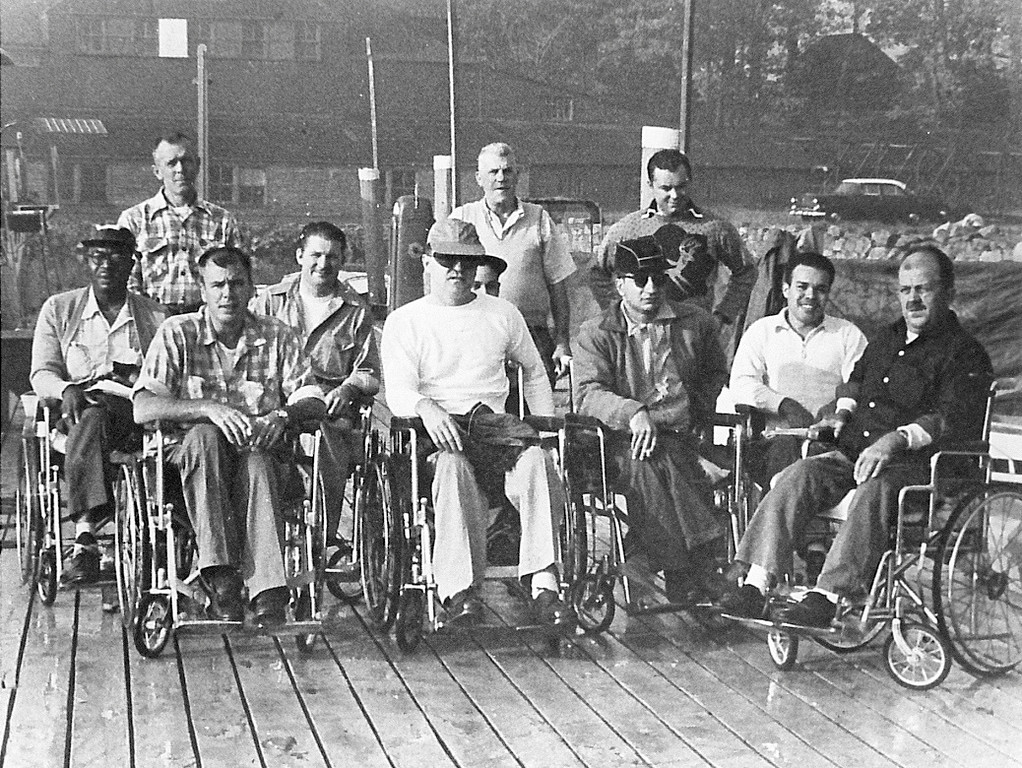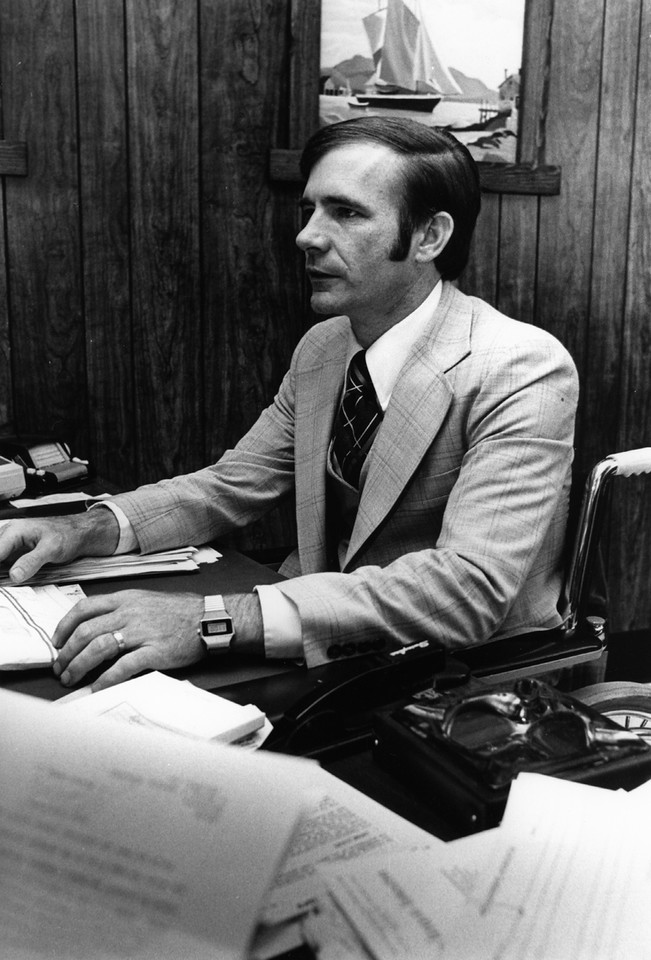 In 1946 Robert Moss rolled his wheelchair down to Grand Central Terminal in New York City and led his fellow World War II veterans in a passionate protest. The comrades, who suffered devastating spinal cord injuries in combat, had only one goal in mind: to simply reintegrate back into society and be afforded the rights and benefits they deserved. Sounds easy right? Not so much.
In 1946 Robert Moss rolled his wheelchair down to Grand Central Terminal in New York City and led his fellow World War II veterans in a passionate protest. The comrades, who suffered devastating spinal cord injuries in combat, had only one goal in mind: to simply reintegrate back into society and be afforded the rights and benefits they deserved. Sounds easy right? Not so much.
The lack of resources, accessibility and knowledge of disabilities left the men lacking proper healthcare, the ability to get an education, and unable to work. But their courageous actions and determined spirit to fight for what they deserved spawned a movement that would play a major role in the formation of United Spinal Association and improve the lives of millions of future generations of Americans; VetsFirst.
“Although United Spinal Association now represents all Americans living with disabilities, we must never lose sight that we started as a veterans’ advocacy group. Veterans are the soul of our organization and I think we do a great job of remembering and serving them with VetsFirst,” says Ross Meglathery, Vice President of VetsFirst.
Pushing for greater independence, equal civil rights, and better treatment at VA hospitals, the men formed the congressionally chartered Paralyzed Veterans of America. The PVA served as both a support group for the men to vent their grievances and as a platform to bring awareness on a legislative level of the needs and rights of those who were left paralyzed fighting for their country. Soon, the group expanded across the country forming localized chapters one of which was the Eastern Paralyzed Veterans Association (EPVA), which transformed into the humble beginnings of United Spinal Association.
“These veterans sought to re-enter the workforce or get an education through the new G.I. Bill. However, they were often not able to get physical access to those things. They organized an order to push for action to allow them entry to those opportunities that they had earned through their service,” says Meglathery.
 “All categories of Americans living with disabilities owe a debt of gratitude to these veterans, for if it was not for them calling attention to their difficulties in getting access, wheelchair accessibility would not be what it is today.”
“All categories of Americans living with disabilities owe a debt of gratitude to these veterans, for if it was not for them calling attention to their difficulties in getting access, wheelchair accessibility would not be what it is today.”
VetsFirst and United Spinal soon merged and over the past 70 years, VetsFirst has blossomed into a premier program of United Spinal Association, helping paralyzed Veteran’s and their families acquire the benefits they deserve and ensure they realize their full potential, achieve the highest level of independence and live a great quality of life. From Korean War vets paralyzed over 60 years ago to Iraq veterans injured two weeks ago, VetsFirst helps all generations of veterans advocating for such things like optimal healthcare, benefits, education and employment services, disability compensation, rehabilitation, and counseling services just to name a few.
And the group’s voice goes far beyond assisting those with paralysis, advocating for wounded veterans suffering from post-traumatic stress disorder and traumatic brain injuries as well.
“We have three core principles by which we stand,” Meglathery says of the organization’s mission. “Community Integration and Independence, Timely Access to Quality VA Health Care and Benefits and Rights of Veterans with Disabilities.”
An injured Iraq War veteran himself, Meglathery has served as Vice President of VetsFirst for the past seventeen months and says the job has fulfilled his strong desire to still serve his country and help his fellow veterans.
“I am a combat wounded Marine veteran of Iraq. Having served in the military, many of my friends are veterans and I am aware of the issues that affect them,” he says. “After my time on active duty, I entered the private sector and worked in the consulting industry. I did not feel fulfilled. While I knew it was time for me to leave the active component of the military, I wanted to continue to serve. I went back to graduate school where I earned a master’s degree in Public Administration. A former United Spinal Association employee informed me of the position at VetsFirst which was right up my alley. Fortunately, it worked out and I am in the very job I had envisioned for myself.”
Providing much more than just supportive words or an encouraging hug, VetsFirst takes their advocacy straight to Capitol Hill to bring awareness and fight for solutions to the issues that affect injured Veterans, achieving numerous major victories over the past seven decades.
During the leadership of the renowned James J. Peters, who served as United Spinal’s president for three decades between the 1970s and 1990s, the organization helped improve the quality of health care for veterans by winning denied benefits for individual veterans and securing money for VA programs and infrastructure.
Peters’ spent the majority of his career working tirelessly to expose the unfair treatment imposed upon veterans. In 1970, the organization made history when Peters’ persuaded Life Magazine to publish a cover story revealing the appalling conditions that spinal cord injured Vietnam vets were enduring at the Bronx VA Medical Center. The article uncovered a harsh reality and brought the somewhat hidden issues facing veterans to the national stage. Triggering a public outcry and grabbing the attention of leaders in Washington D.C., the Bronx VA Medical Center was completely demolished and rebuilt from the ground up per Congressional order. Renamed in honor of Peters’ in 2005, the hospital now specializes in spinal cord injury care and recovery.
Echoing Peters’ legacy, Meglathery says that in order to see improvements it is imperative to continually spread awareness and keep the public engaged on the unseen struggles of many vets.
“It is not that the American public does not want to support our veterans. In fact, it is quite the opposite,” he says. “However, if the public are not aware of the issues facing the veteran community, then they will not have reason to push their elected officials to act in ways that help veterans.”
A recent successful tool to spread awareness and engage injured vets as well as the general public is the addition of the Ask VetsFirst online helpdesk. Available 24 seven at vetsfirst.org, the helpdesk is a fully stocked online resource center with information on a wide variety of veteran’s issues and topics. Counselors are available to answer questions on every topic ranging from claim appeals to state benefits. A call center is also available to provide a friendly voice, answer questions, provide support and offer guidance.
“What makes it so successful is that it has proven to be a helpful resource beyond our constituency of spinal cord injured veterans,” Meglathery says of the helpdesk. “Essentially, any category of veteran, caretakers, family members, lawyers representing a veteran, and even upon occasion another veterans’ service organization, can email us a question about benefits. We respond within 72 hours. This is a success for them too because in a time where the Department of Veterans Affairs is criticized for being a slow moving bureaucracy, we can assist a constituent in getting an answer accurately and quickly.”
Although commonly acknowledged as a VA service organization, Meglathery says VetsFirst insists on being recognized as a direct representation of veteran’s and their families instead of a formalized government institution and he hopes to engage more vets to join the cause.
“We view our members and their local chapters as our key constituency and resource,” Meglathery says. “It is my desire to be able to grow our veteran membership at the chapter level. Additionally,I would love to hear more from our chapter member veterans and be able to tell their individual story.”
Motivated and armed with ideas, Meglathery has already played an integral role in his short stint as Vice President, helping the organization achieve many recent milestones and accomplishments and he says his goals for the future of the organization are endless.
“I am always trying to find ways where we can help the Department of Veterans Affairs do a better job of serving veterans,” he says. “I spend a lot of time on Capitol Hill working with Congress and the Executive branch. It is my goal is to continue to provide our input to pending legislation. Furthermore, I am working on helping craft new legislation designed to reform certain programs that are not working for veterans. Hopefully, there will be more to follow on this front.”
When asked the importance the organization has had on him and veterans everywhere, Meglathery sums it up plain and simply.
“I would say it means a way of remembering who we are.”
— Maureen Gazda


